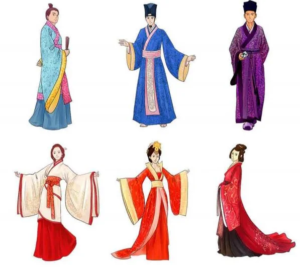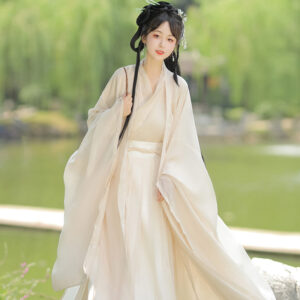

In ancient China, social status profoundly influenced Hanfu styles, dictating various aspects of clothing such as materials, colors, designs, and overall presentation. Here’s a detailed overview of how social hierarchy affected Hanfu:
1. Materials Used
- Silk vs. Common Fabrics: The upper classes, including royalty and high-ranking officials, predominantly wore silk garments, which were luxurious and expensive. Silk’s luster and texture made it a clear status symbol. In contrast, commoners typically wore simpler garments made from hemp or cotton, which were more affordable and practical but lacked the elegance of silk13.
2. Color Significance
- Color Restrictions: Certain colors were reserved for specific social classes. For instance, yellow was exclusively worn by the emperor, symbolizing supreme authority. Nobility often favored purples and deep blues, colors that were costly to produce and thus indicated wealth and high status. Commoners were limited to muted tones or undyed fabrics, further emphasizing the social divide14.
3. Design Elements
- Intricate vs. Simple Designs: The designs of Hanfu varied greatly by social class. Nobles wore garments adorned with elaborate embroidery featuring auspicious symbols like dragons and phoenixes, indicating power and prosperity. In contrast, commoners’ Hanfu was more functional and modest, focusing on practicality rather than decoration13.
4. Accessories and Embellishments
- Role of Accessories: Accessories played a crucial role in signaling social status. High-ranking individuals adorned their outfits with intricate hairpins, jade ornaments, and luxurious belts. Commoners had simpler accessories that reflected their economic constraints24.
5. Regulations and Dress Codes
- Legal Restrictions: There were strict dress codes enforced by law that dictated what individuals could wear based on their social standing. Violating these codes could result in severe penalties. This legal framework ensured that clothing remained a clear indicator of one’s place in society13.
6. Cultural Reflections
- Symbolism in Attire: The choice of materials, colors, and designs was not merely aesthetic but deeply symbolic, reflecting Confucian values of hierarchy and order. Each garment served as a visual representation of an individual’s social status and role within the community24.
Conclusion
The relationship between social status and Hanfu styles in ancient China was complex and multifaceted. Clothing served as a powerful indicator of one’s position in society, with every detail—from fabric choice to color—conveying specific meanings about wealth, rank, and cultural identity. This structured approach to attire reinforced societal norms and hierarchies throughout Chinese history.
Share this post
Recent Posts


What were the key features of Hanfu during the Tang Dynasty?

How did Hanfu styles vary during different Chinese dynasties?

What accessories are typically worn with Hanfu?

How do you choose the right Hanfu for different seasons?

Newsletter
Popular Categories
Related Post
Sed aliquam, tortor et sodales malesuada, lorem leo luctus tellus, quis interdum eros nibh in nunc. Cras dignissim malesuada, lorem leo luctus

What are the winter hanfu called?

What were the key features of Hanfu during the Tang Dynasty?

How did Hanfu styles vary during different Chinese dynasties?


